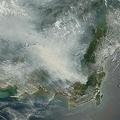 根據《自然地球科學期刊》中所發表的最新研究論文指出,柴油廢氣、生質燃燒以及使用固體燃料烹煮所產生的黑碳懸浮微粒,對全球暖化的貢獻值,約為目前預估的3到4倍。
根據《自然地球科學期刊》中所發表的最新研究論文指出,柴油廢氣、生質燃燒以及使用固體燃料烹煮所產生的黑碳懸浮微粒,對全球暖化的貢獻值,約為目前預估的3到4倍。
加州史奎普斯海洋研究院大氣科學家拉曼納森(V. Ramanathan ),以及愛荷華大學化學工程師凱米歇爾(Greg Carmichael)表示,煤煙或其他形式的黑碳,所導致的全球暖化效應程度,約是二氧化碳的6成,其影響程度較二氧化碳以外的其他溫室效應氣體都來的高。
除了減少溫室氣體排放量的長期影響外,研究人員表示減緩黑碳微粒還可產生直接的社會利益。在文章中,拉曼納森和凱米歇爾統整了經由衛星、航空器以及測量黑碳全球暖化效應相關地面設備所觀測到的數據後,發現其在大氣中所產生的暖化現象約為每平方米0.9瓦特。
這與聯合國贊助、定期整理氣候變遷研究的「氣候變遷專家小組」2007年所公佈的研究報告中,一致認為約每平方米0.2瓦特到0.4瓦特的數據有所落差。
拉曼納森和凱米歇爾表示,較基本保守的評估主要以普遍應用的電腦模型模擬為基礎,一旦黑碳與類似硫酸鹽這類氣懸膠混合在一起時,電腦無法將黑碳全球暖化效應的擴大納入考量。而這種模型也無法充分重現所有產生溫室效應的海拔高度。
最新的觀測數據在海拔6500英尺測量到明顯的黑碳暖化效應,在這種高度下,黑碳懸浮微粒不只吸收了陽光,同時也吸收了低海拔地區雲層所反射的太陽能。
 大氣中的黑碳約有25%到35%來自中國和印度,主要從一般家庭中焚燒木材和牛糞,以及為了給室內供暖所使用的煤炭中釋放出來。歐洲及其他高度仰賴柴油做為運輸能源的國家也貢獻了相當大數量的排放量。
大氣中的黑碳約有25%到35%來自中國和印度,主要從一般家庭中焚燒木材和牛糞,以及為了給室內供暖所使用的煤炭中釋放出來。歐洲及其他高度仰賴柴油做為運輸能源的國家也貢獻了相當大數量的排放量。
拉曼納森指出:「美國或其他歐洲國家的人均黑碳排放量仍與東亞、南亞國家相當。」
在南亞,空氣污染時常引發灰霾,在拉曼納森先前的研究中就發現,這類煙霧所產生的暖化效應,可能讓做為亞洲數十億人口飲用水源的喜馬拉雅山冰河融化速度加快。
此外,在室內烹調吸入油煙,也已在東亞和南亞造成約40萬名婦女和孩童死亡。
※ 附註:「氣懸膠」原文為aerosol,也有人譯為「氣膠」、「氣溶膠」。如今舊譯「浮質」已幾乎無人使用。「氣懸膠」係指一團氣體與懸浮在其中的微粒,包含固體與液體。粉塵(dust)、煙(smoke)、霧(mist)、煙霧(smog) 與霾(haze) 等都算是其中一種。
Black carbon, particulate matter in the air produced by diesel exhaust, biomass burning, and cooking with solid fuels, has a warming effect in the atmosphere three to four times greater than existing estimates, according to scientists in an upcoming review article in the journal "Nature Geoscience."
Atmospheric scientist V. Ramanathan with the Scripps Institution of Oceanography at University of California-San Diego and University of Iowa chemical engineer Greg Carmichael, said that soot and other forms of black carbon could have as much as 60 percent of the current global warming effect of carbon dioxide, more than that of any greenhouse gas besides carbon dioxide, CO2.
The researchers also say that mitigation would have immediate societal benefits in addition to the long-term effect of reducing greenhouse gas emissions.
In the paper, Ramanathan and Carmichael integrated observed data from satellites, aircraft and surface instruments about the warming effect of black carbon and found that its warming effect in the atmosphere, is about 0.9 watts per meter squared.
That compares to estimates of between 0.2 watts per meter squared and 0.4 watts per meter squared that were agreed upon as a consensus estimate in a report released last year by the Intergovernmental Panel on Climate Change, a United Nations sponsored agency that periodically synthesizes the body of climate change research.
Ramanathan and Carmichael said the lower, more conservative estimates are based on widely used computer model simulations that do not take into account the amplification of black carbon's warming effect when mixed with other aerosols such as sulfates.
The models also do not adequately represent the full range of altitudes at which the warming effect occurs, they said.
The most recent observations have found significant black carbon warming effects at altitudes in the range of 6,500 feet, levels at which black carbon particles absorb not only sunlight but also solar energy reflected by clouds at lower altitudes.
Between 25 and 35 percent of black carbon in the global atmosphere comes from China and India, emitted from the burning of wood and cow dung in household cooking and through the use of coal to heat homes.
Countries in Europe and elsewhere that rely heavily on diesel fuel for transportation also contribute large amounts.
"Per capita emissions of black carbon from the United States and some European countries are still comparable to those from south Asia and east Asia," Ramanathan said.
In south Asia, air pollution often forms a brownish haze. Ramanathan's previous research has indicated that the warming effects of this smog appear to be accelerating the melt of Himalayan glaciers that provide billions of people throughout Asia with drinking water.
In addition, the inhalation of smoke during indoor cooking has been linked to the deaths of an estimated 400,000 women and children in south and east Asia.
全文及圖片詳見:ENS



